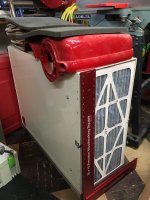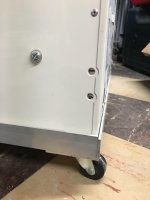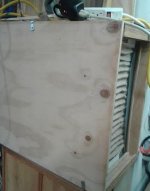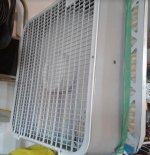Using the Rotex 125 in aggressive mode yesterday convinced me that I need some air filtration in my basement shop (12x22x8). While the Ct22 connected to the sander did a decent job of dust collection, there was still enough in the air to be worrisome (I was wearing a mask) about it settling on other surfaces and getting pulled into the HVAC system.
I'm curious what others here use for air filtration (commercial or DIY) and your experiences and recommendations. A primary concern for me is the noise level of the system as well as energy efficiency and effectiveness.
A casual look at commercial shop air filtration systems shows many of the hang from the ceiling or wall type units with the Jet 1000B a favorite, but it seems to be very noisy. There are a variety of comparisons of these units, including this one fromhttps://www.woodmagazine.com/tool-reviews/dust-collection/air-filtration-systems. One improvement on these systems is the use of a Wynn filterhttps://wynnenv.com/products-page/cyclone-filter-pricing/9l300nano/
attached to the intake of units like the Jet. Stumpy Nubs has a YouTube video about doing this.
YouTube and various websites are full of DIY box fan and filter solutions like these from Shop Hacks.https://www.shophacks.com/newslette...ve-low-cost-diy-box-fan-filtration-systems#/. These solutions use a variety of blowers and fans to take air in through MERV 12 or so filters and exhaust it out. Triangles and cubes seem to be the common configurations. I think these are likely to be noisy and not very energy efficient, depending on the fan.
These DIY solutions gave me the idea of maybe using a quiet and energy efficient inline exhaust fan with some filter media. I used one fromAC Infinity to solve a crawl space problem in the past and I was happy with how quiet and energy efficient those fans are. But, there may not be enough air flow to do the job.I 'm calling them tomorrow too see what they think of this application for their fans.
Anyway, curious about others solutions to the air filtration issue.
I'm curious what others here use for air filtration (commercial or DIY) and your experiences and recommendations. A primary concern for me is the noise level of the system as well as energy efficiency and effectiveness.
A casual look at commercial shop air filtration systems shows many of the hang from the ceiling or wall type units with the Jet 1000B a favorite, but it seems to be very noisy. There are a variety of comparisons of these units, including this one fromhttps://www.woodmagazine.com/tool-reviews/dust-collection/air-filtration-systems. One improvement on these systems is the use of a Wynn filterhttps://wynnenv.com/products-page/cyclone-filter-pricing/9l300nano/
attached to the intake of units like the Jet. Stumpy Nubs has a YouTube video about doing this.
YouTube and various websites are full of DIY box fan and filter solutions like these from Shop Hacks.https://www.shophacks.com/newslette...ve-low-cost-diy-box-fan-filtration-systems#/. These solutions use a variety of blowers and fans to take air in through MERV 12 or so filters and exhaust it out. Triangles and cubes seem to be the common configurations. I think these are likely to be noisy and not very energy efficient, depending on the fan.
These DIY solutions gave me the idea of maybe using a quiet and energy efficient inline exhaust fan with some filter media. I used one fromAC Infinity to solve a crawl space problem in the past and I was happy with how quiet and energy efficient those fans are. But, there may not be enough air flow to do the job.I 'm calling them tomorrow too see what they think of this application for their fans.
Anyway, curious about others solutions to the air filtration issue.




